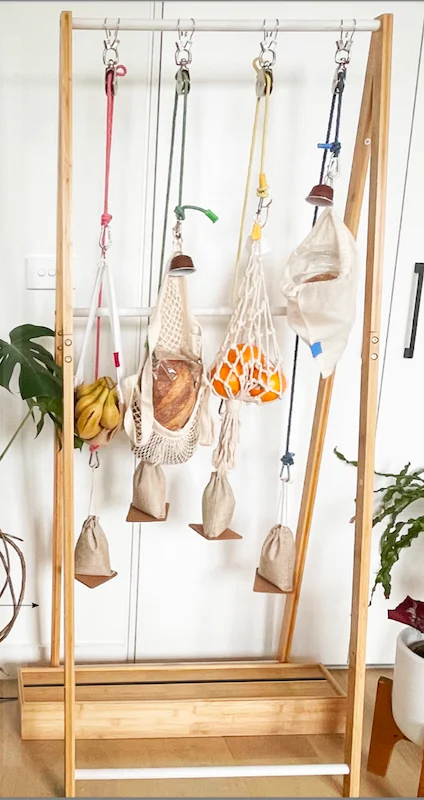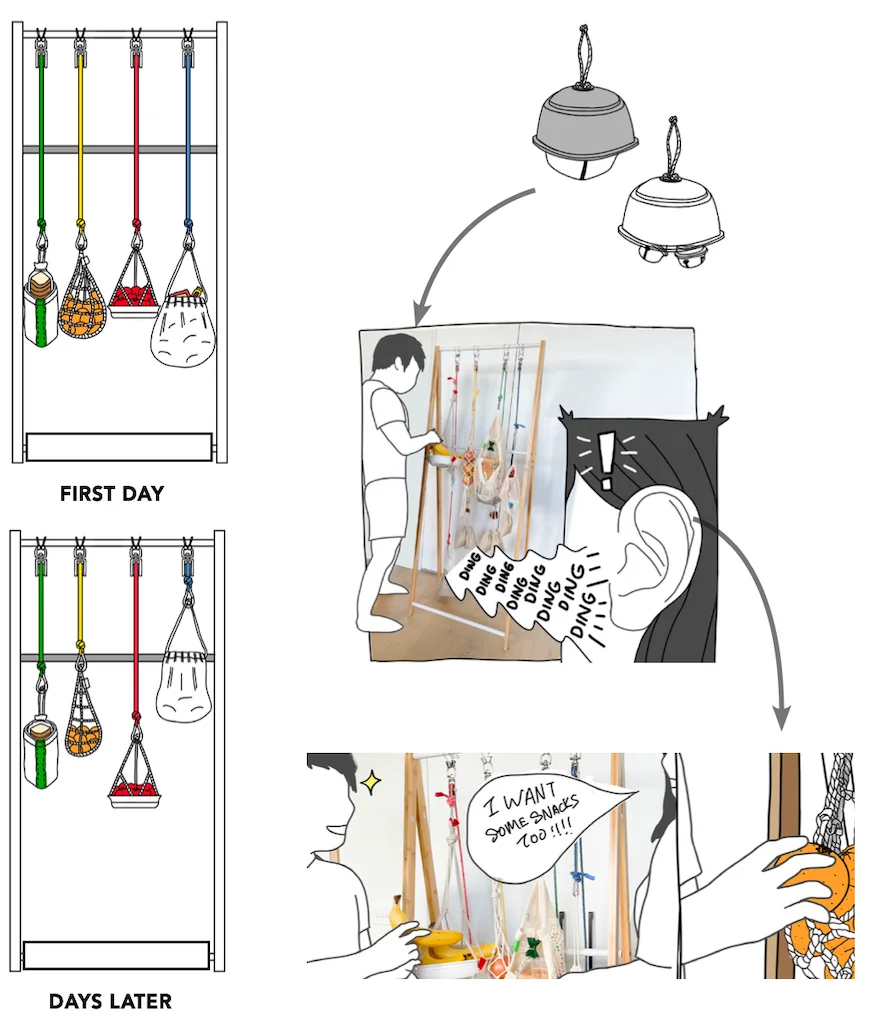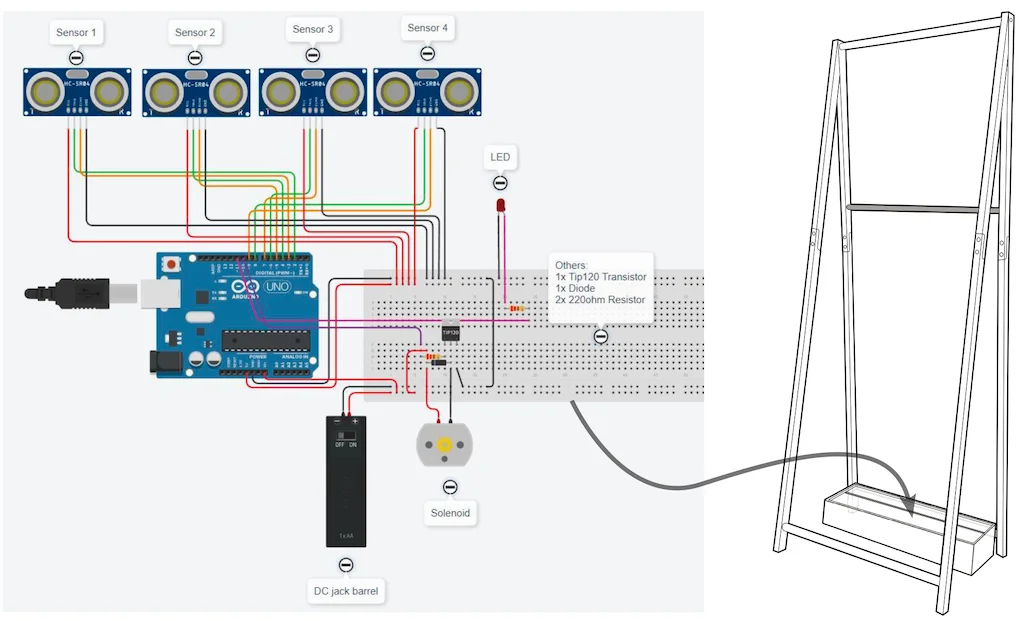FoodChestra
Made with ❤️ by Rohit Ashok Khot & Yi Ling (Ellie) Tai

FoodChestra revolutionizes food storage and interaction with its intelligent pantry system. This furniture-style structure combines functionality and aesthetics, eliminating cluttered and disorganized pantries. The innovative pulley system of FoodChestra allows easy access and display of various food items. No longer hidden in closed cabinets, items are proudly showcased, making it easier to choose what to eat and adding elegance to the kitchen. But FoodChestra goes beyond storage. It offers valuable insights into eating habits through multimodal feedback. A standout feature is FoodChestra's reminder if a food item goes untouched for a day, promoting responsible consumption and reducing waste. FoodChestra also fosters self-reflection and communal engagement. By transitioning to an open system, it encourages users to reflect on their choices and consider the nutritional value of their meals. It creates a shared experience around food, promoting overall well-being.
What makes FoodChestra unique?
In a world grappling with the staggering issue of food waste, the FoodChestra emerges as a groundbreaking solution, transcending the conventional boundaries of domestic food storage and consumption practices. Developed as a smart open food pantry, FoodChestra isn't just a piece of furniture; it's a transformative experience designed to foster understanding and reflection on our relationship with food.
FoodChestra in Action
Addressing the Global Food Waste Crisis
The harsh reality, highlighted by the Australian Food Bank, indicates that households contribute significantly to the global food waste epidemic. Fast-paced urban lifestyles, coupled with on-the-go food practices, result in unnecessary food purchases that often end up in the bin. The prevalent storing practices, hidden away in layered pantries and refrigerators, create a notorious 'out of sight, out of mind' scenario, contributing to the alarming levels of domestic food waste. FoodChestra steps in as a beacon of change, poised to revolutionize how we store, interact with, and consume food at home.
Designing a Sustainable Solution
FoodChestra is not just a concept; it's the culmination of eight months of meticulous design and refinement. The process involved a Constructive design approach, guided by a profound research gap in food waste and domestic food practices. The design team delved into the intricacies of selecting suitable materials, choosing storage methods, exploring feedback options, and ensuring practical usability through real-world testing. Every decision in the design process followed a sequential and deliberate path, with lead designers rigorously testing the system in their own homes. The practical use of real foods with varying shelf life and storage requirements allowed the team to fine-tune aspects such as material choices, auditory feedback, and breathability for optimal storage.




Transformative concept
At the heart of FoodChestra is a transformative concept inspired by the trend of open closets and traditional methods of displaying food. The open pantry structure, akin to open closets, not only serves a functional purpose but also becomes a conversation starter, encouraging shared reflections on food consumption practices. FoodChestra seeks to redefine the mundane act of storing food into a playful and inviting experience, promoting natural interaction over mere educational purposes. Crafted from natural materials like bamboo and linen, FoodChestra seamlessly blends into its surroundings when not in use. Eschewing attention-seeking lights and electronic components, it relies on intelligent visual representations through the pulley-based mechanisms. The minimalist design extends to the assembly process, following a DIY-style approach that empowers users to customize the system according to their household requirements.
Multimodal interaction
FoodChestra incorporates a pulley-based mechanism with specially designed bags, creating a symphony of sensory interactions – auditory, visual, tactile, and olfactory. The subtle cow-bell sound upon interaction and the altered heights of the food bags serve as visible and audible indications of previous interactions. By placing FoodChestra in shared living spaces, it becomes a communal experience, allowing everyone to witness an individual's food consumption patterns.
Encouraging Reflection, Not Imposing Habits
Unlike solutions that dictate new eating habits, FoodChestra respects individual preferences and existing habits. It encourages users to reflect on their current practices and provides them the agency to modify those habits based on personal choices. It doesn't force change; it inspires mindful reflection and, subsequently, change at the user's own pace. In essence, FoodChestra transcends the realm of furniture and becomes an instrument of change in the global fight against food waste. It's not just about storing food; it's about revolutionizing our relationship with what we eat, one pulley bag at a time. Welcome to the future of sustainable domestic food practices – welcome to FoodChestra.

